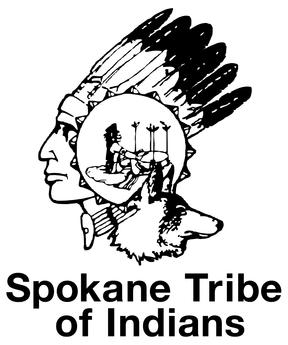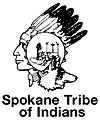Spokane people facts for kids
| Sqeliz | |
|---|---|

Tribal logo (ca. 2006)
|
|
| Total population | |
| 2,900 | |
| Regions with significant populations | |
| Languages | |
| English, Salish (dialect of Kalispel-Pend d'Oreille language) |
|
| Religion | |
| Dreamer Faith, traditional tribal religion, Christianity | |
| Related ethnic groups | |
| Bitterroot Salish, Coeur D'Alene, Kootenai, Pend d'Oreilles, and other Interior Salish tribes |
The Spokane people are a Native American tribe. They live in eastern Washington state and parts of northern Idaho.
The Spokane Indian Reservation is in northeastern Washington state. Its main town is Wellpinit. Most of the reservation is in Stevens County. It also has small areas in Lincoln County, including part of the Spokane River. The reservation covers about 615 square kilometres (237 sq mi).
The city of Spokane, Washington is named after the tribe. It grew along the Spokane River. This area was once the tribe's land, but it is not part of the reservation.
The Spokane language is part of the Interior Salishan language family. It is a dialect of Montana Salish. Because of their language and culture, the Spokane are closely related to the Bitterroot Salish (Flathead) and Pend d'Oreilles tribes. They often worked with other Plateau tribes. Sometimes, the Kutenai, Crow Nation, and Cree-Assiniboine tribes joined them. They all stood against their common enemies, the Blackfoot Confederacy and later the Lakota people.
Before Europeans arrived, about 1,400 to 2,500 Spokane people lived here. Their numbers dropped after they met settlers and traders. This was because of new diseases brought by Europeans. The Spokane people had no protection against these illnesses. By 1829, a trader thought only about 700 Spokane people remained. Since the early 1900s, their population has grown. In 2019, the tribe reported about 2,900 members.
Contents
What Does the Name Spokane Mean?
The name Spokane was first written down in 1807. Some people think it means "Sun children" or "children of the Sun." Others believe it means "Muddy people."
According to one expert, the name might come from Spoqe'ind, which means "round head." The word sqeliz, meaning "people," is also used by the Spokane to describe themselves.
Spokane History: A Journey Through Time
For thousands of years, the Spokane people lived near the Spokane River. This area is now eastern Washington and northern Idaho. They survived by hunting animals and gathering plants. Spokane land once covered over three million acres.
The Spokane lived along the river in three main groups: the Upper, Middle, and Lower Spokane Indians. They moved with the seasons, following game and plants for nine months of the year. For the other three months, they stayed in permanent winter villages.
Early European Contact
The first Europeans the Spokane met were fur traders and explorers. The Lewis and Clark Expedition met the Spokane tribe in 1805. At this time, the Spokane population was already shrinking. This was due to diseases like smallpox that came from Europe.
Soon after Lewis and Clark, more fur traders and settlers arrived. In 1810, the North West Company opened the Spokane House. This was a trading post near where the Spokane and Little Spokane rivers meet. The Pacific Fur Company built Fort Spokane in 1811. Much later, from 1898 to 1906, this building was used as an Indian boarding school for Spokane children.
The Spokane tribe played a big part in the Coeur d'Alene War of 1858. This was a series of fights between Native American tribes and the United States Army. The Spokane, Coeur d'Alene, Pend d'Oreille, Palouse, and Northern Paiute tribes worked together. The battles happened in Spokane lands in Washington and Idaho.
Moving to Reservations
Through a treaty with the government, the Spokane people gave up most of their land. They agreed to move to the Spokane Reservation, which was created in 1881. In 1877, the Lower Spokane people agreed to move to this reservation.
In 1887, the Upper Spokane people and Middle Spokane people agreed to move to the Colville Reservation. This reservation was mostly home to the Colville people. Not all Spokane people left their traditional lands. This caused some problems with white settlers.
In the Nez Perce War of 1877, the Spokane tribe stayed neutral. This was even though Nez Perce chief Chief Joseph asked them to join him. He wanted to try and make the settlers leave.
Modern History and Challenges
Around the 1950s, a valuable mineral called uranium was found on the reservation. It was mined from 1956 to 1962. Later, from 1969 to 1982, uranium was mined at the Midnite Mine. This mine is now closed. It is on a list of sites that need cleaning up. The mining left the land and water polluted.
Building dams on the Spokane River also changed things for the Spokane people. These dams made electricity and provided water for farms. The Little Falls dam stopped most of the salmon from swimming upriver to Spokane Falls. The Grand Coulee Dam on the Columbia River completely blocked salmon from reaching the Spokane River. This ended all salmon runs there.
Today, the Spokane Tribe is one of several tribes in the northwestern United States that offers free bus service on its reservation.
How the Spokane Tribe Was Organized
The Spokane tribe was split into three main groups based on where they lived: upper, lower, and middle. Each area had smaller groups called bands. These bands were made up of related families.
- The Upper Spokane lived along the Little Spokane River. Their name means "People of the Falls."
- The Middle Spokane lived near Spokane Falls. Their name means "People of the steelhead river." This area includes Spokane House, the first permanent white settlement in Washington State.
- The Lower Spokane lived along the lower Spokane River. Their name means "People of Little Falls."
Each band had a chief and a sub-chief. They were chosen for their leadership skills. Decisions were made by everyone in the group agreeing.
The Spokane people often followed a custom where the husband would move to live with his wife's family after marriage. Sometimes, the wife would move to her husband's family. People could also move between different bands. A person or family might spend one winter with one band and the next with another.
Spokane Lifestyle and Daily Life
The Spokane diet included fish, local game, and plants. Men hunted deer, which gave them important food in the winter. They tracked deer and used bows and arrows to hunt them.
Fish, especially salmon, were a huge part of the Spokane diet. They were also important for trade. The Spokane people also ate trout and whitefish. They would smoke or dry fish to trade or to store for winter. Fish eyes were seen as a special treat.
Women gathered plants, which made up almost half of the Spokane tribe's food.
Roles of Men and Women
Spokane men made tools, fished, and hunted. After the tribe got horses, men took care of and trained these animals. Horses became a sign of wealth. They allowed people to travel further and carry supplies. Men rode horses when hunting and during battles. The Spokane tribe got horses from the Nez Perce, Kalispel, or Flathead tribes. By about 1800, the Spokane tribe had many horses.
Spokane women made baskets from birch bark or cedar roots. They wove bags from animal hides. They also sewed mats and other items. These items were sometimes traded with other Native peoples and white traders. Some plants they gathered included camas roots and local berries. Women used digging sticks to pull up and gather their food. This tool was very important. Young girls were given their first digging sticks as a special event. Women's graves were often marked with these sticks.
Spokane Religion and Beliefs
One Spokane religion was the Dreamer Cult. It was also called Washani, meaning "worship" or "dancers." This religion grew among the Columbia Plateau tribes in the late 1800s. It came about because of the challenges of colonization.
The Dreamer Cult mixed traditional beliefs with parts of Christianity. The Dreamer prophets did not accept non-Native culture. They told people to go back to their old ways of life. Before Europeans arrived, Plateau Indian spirituality included Winter dances, personal vision quests, and seasonal feasts. These were linked to the yearly food cycle and gaining spirit powers.
Some spiritual dances included the Prophet Dance and the Spirit Dance. These took place in mid-January. Dancers tried to connect with the Prophet's spirit. In the Spirit Dance, a shaman would ask a spirit to visit a person.
A prophet named Smohalla had a vision. He believed that white people would disappear. He thought that Native Americans who had died would come back to life. He also believed the world would return to its perfect state. This change did not need violence. Most Dreamers taught peace. To make this happen, Native Americans had to follow the Creator's instructions, as told by the prophets.
The Dreamer Cult was important among the Columbia Plateau peoples until the early 1890s. Then, the main prophets died. Their followers began to lose hope in a world free of white people. Today, the Seven Drums Religion is the closest religion to the Washani.
Spokane Stories and Myths
Creation Story
The Creator, Amotkan, made light. First, the animals tried to make it. Woodpecker tried to go up a pole, but it was too hot. Coyote tried, but he was too loud. Bear tried, but it was too cold. Then, thunder broke a red rock. This rock turned into a handsome red man. He wanted a brother. Amotkan gave him one made from the root of an herb.
The two brothers went to a lodge where a witch, Lady Bullfrog, lived. She liked the brother made from the root so much that she jumped onto his face and stuck there. When he pulled her off, she tore out one of his eyes. He then decided to go into the sky to be light for the earth. He did not want people to see his face with one eye missing. So, he became the sun. When people look at him, they have to close one of their own eyes.
The other man joined his brother in the sky. But before he did, Lady Bullfrog jumped onto his face too. He became the moon. Today, if you look closely at the moon, you can see Lady Bullfrog clinging to his face.
Because he was lonely, Coyote made the Spokane man. Coyote mixed pitch, clay, hot rock, and reeds. He added berries, smoke, and fire to create the Spokane man. With the same things, he made the Spokane woman. Amotkan, the Creator, gave her life.
The man and woman soon became wild. They did not care much for the safety of others. Then, a flood covered the land. It destroyed almost everyone. The few who survived stayed together for safety. They chose a leader and had many children. Over time, the leader divided the people into small groups. These groups became the different tribes.
Notable Spokane People
- Sherman Alexie (Spokane-Coeur d'Alene), a famous author and filmmaker.
- Gloria Bird, a poet and scholar.
- Betty David, a fashion designer.
- Chief Garry or Spokane Garry, a 19th-century tribal leader and diplomat.
- Charlene Teters, an artist and activist.
Images for kids
See also
 In Spanish: Spokane para niños
In Spanish: Spokane para niños


